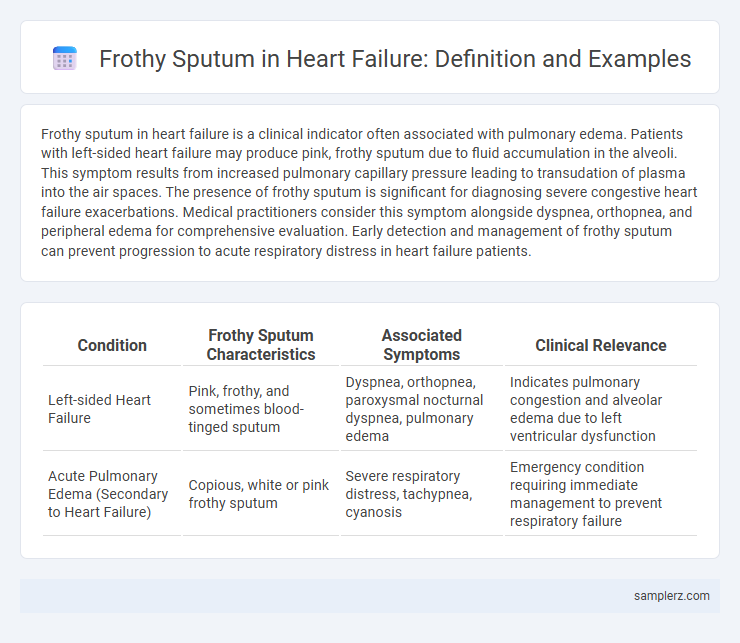Frothy sputum in heart failure is a clinical indicator often associated with pulmonary edema. Patients with left-sided heart failure may produce pink, frothy sputum due to fluid accumulation in the alveoli. This symptom results from increased pulmonary capillary pressure leading to transudation of plasma into the air spaces. The presence of frothy sputum is significant for diagnosing severe congestive heart failure exacerbations. Medical practitioners consider this symptom alongside dyspnea, orthopnea, and peripheral edema for comprehensive evaluation. Early detection and management of frothy sputum can prevent progression to acute respiratory distress in heart failure patients.
Table of Comparison
| Condition | Frothy Sputum Characteristics | Associated Symptoms | Clinical Relevance |
|---|---|---|---|
| Left-sided Heart Failure | Pink, frothy, and sometimes blood-tinged sputum | Dyspnea, orthopnea, paroxysmal nocturnal dyspnea, pulmonary edema | Indicates pulmonary congestion and alveolar edema due to left ventricular dysfunction |
| Acute Pulmonary Edema (Secondary to Heart Failure) | Copious, white or pink frothy sputum | Severe respiratory distress, tachypnea, cyanosis | Emergency condition requiring immediate management to prevent respiratory failure |
Understanding Frothy Sputum in Heart Failure
Frothy sputum in heart failure often appears pink-tinged due to pulmonary edema caused by left ventricular dysfunction. This frothy, bubbly secretion results from fluid accumulation in the alveoli, impairing gas exchange and leading to shortness of breath. Recognizing pink frothy sputum as a clinical sign is crucial for early diagnosis and effective management of acute decompensated heart failure.
Causes of Frothy Sputum Among Heart Failure Patients
Frothy sputum in heart failure patients is primarily caused by pulmonary edema, where increased pressure in the pulmonary capillaries forces fluid into the alveoli, mixing with air to create a characteristic frothy appearance. Left ventricular dysfunction leads to elevated left atrial pressure, resulting in fluid accumulation in lung interstitium and alveoli. This fluid intermittently mixes with trapped air, producing pink, frothy sputum indicative of acute decompensated heart failure.
How Pulmonary Edema Leads to Frothy Sputum
Pulmonary edema in heart failure causes fluid to accumulate in the alveoli, mixing with air and forming frothy sputum. Elevated left atrial pressure forces plasma into the lung interstitium, increasing capillary permeability and resulting in protein-rich, frothy secretions. This characteristic sputum often appears pink-tinged due to red blood cell leakage from damaged capillaries.
Clinical Presentation: Identifying Frothy Sputum
Frothy sputum in heart failure typically appears pink or blood-tinged, indicating pulmonary edema due to increased left ventricular pressure. Patients often present with dyspnea, orthopnea, and audible crackles on lung auscultation accompanying this hallmark expectoration. Identifying frothy sputum helps clinicians diagnose acute decompensated heart failure and initiate appropriate diuretic and supportive therapies promptly.
Diagnostic Importance of Frothy Sputum in Cardiac Conditions
Frothy sputum, often pink-tinged, serves as a critical diagnostic indicator of acute pulmonary edema in heart failure, signaling fluid accumulation in the lungs due to left ventricular dysfunction. Identifying frothy sputum helps clinicians differentiate cardiac-related respiratory distress from pulmonary or infectious causes. Early recognition of this symptom guides timely intervention, reducing morbidity and improving patient outcomes in cardiac conditions.
Frothy Sputum vs. Other Sputum Types in Heart Conditions
Frothy sputum, often pink-tinged due to pulmonary edema, is a classic indicator of acute left-sided heart failure, resulting from increased hydrostatic pressure causing fluid leakage into the alveoli. Unlike mucoid sputum seen in chronic bronchitis or purulent sputum typical of bacterial pneumonia, frothy sputum is characterized by its airy, bubbly texture and presence of plasma proteins. Recognizing frothy sputum aids clinicians in differentiating cardiogenic pulmonary edema from infectious or inflammatory pulmonary conditions.
Case Study: Frothy Sputum as a Heart Failure Symptom
Frothy sputum, often pink-tinged, is a hallmark symptom in acute decompensated heart failure, resulting from pulmonary edema due to increased hydrostatic pressure in pulmonary capillaries. In a case study of a 68-year-old male with chronic heart failure, the presence of frothy sputum accompanied by dyspnea and orthopnea indicated worsening left ventricular function requiring urgent medical intervention. Diagnostic imaging revealed pulmonary congestion, confirming that frothy sputum serves as a critical clinical marker for fluid accumulation in alveoli associated with heart failure exacerbation.
Emergency Response to Frothy Sputum in Heart Failure
Frothy sputum in heart failure often signals acute pulmonary edema, requiring immediate emergency response to prevent respiratory failure. Rapid administration of oxygen, diuretics such as intravenous furosemide, and vasodilators are critical to reduce pulmonary congestion and improve cardiac output. Continuous monitoring of vital signs and oxygen saturation is essential to guide therapy and assess the effectiveness of interventions in acute decompensated heart failure.
Managing and Treating Frothy Sputum in Cardiac Patients
Managing frothy sputum in heart failure involves optimizing diuretic therapy to reduce pulmonary congestion and improve alveolar fluid clearance. Supplemental oxygen and non-invasive ventilation support oxygenation and decrease respiratory distress in severe cases. Monitoring electrolyte balance and addressing underlying cardiac dysfunction through medications like ACE inhibitors and beta-blockers are essential to prevent recurrence and improve overall cardiac function.
Prognostic Value of Frothy Sputum in Heart Failure Outcomes
Frothy sputum in heart failure often indicates pulmonary edema and is a critical marker of severe left ventricular dysfunction. Its presence correlates with higher rates of hospital readmission and increased mortality risk due to compromised cardiac output and fluid overload. Monitoring frothy sputum can aid clinicians in prognostic assessment and guide aggressive therapeutic interventions to improve patient outcomes.

example of frothy sputum in heart failure Infographic
 samplerz.com
samplerz.com